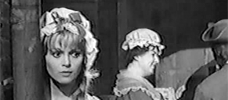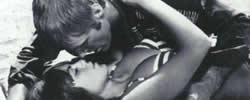Reviews
Megavixens / Three Ways to Love
Russ Meyer
USA, 1970
Credits
Review by Chiranjit Goswami
Posted on 05 September 2008
Source RM Films International DVD
Categories Bosomania!: The Sex, the Violence, and the Vocabulary of Russ Meyer
Released only a few months before his scintillating masterpiece, Beyond the Valley of the Dolls, Russ Meyer’s Cherry, Harry & Raquel begins with a brief scroll of text denouncing the needlessly arrogant efforts of morality watchdogs who attempt to restrict personal freedom, while noting how modern society ignores its own detrimental impact upon nature. The condemnation is superimposed upon one of Meyer’s trademark montages, replete with scenes of nude women prancing around in various sultry positions frenetically intercut with a medley of skewed and smoggy images of erect skyscrapers and grinding industrial machinery. Although Meyer’s montages typically forge sex into some sort of ridiculous juxtaposition (with Mennonites flying kites, for one), with Cherry, Harry, & Raquel’s preliminary text and images, Meyer creates an opposition rather than an association. The distinction may appear meaningless during the movie’s preamble, but this idea of conflict will become more imperative as the movie progresses.
Moments later, amidst scenery of barren desert landscapes and bustling modern cities, Meyer delivers a lengthy lecture regarding the poisonous impact that “the mind-bending narcotic” marijuana has upon American society, made possible largely due to the boredom afforded to a wealthy middle-class. The potentially tongue-in-cheek sermon is highly ironic considering the film’s initial crusade in support of civil liberties. Accompanied by distinctly masculine narration, Meyer’s rotates through images normally associated to an affluent lifestyle, which the commentary refers to as “the American Dream come true.” However, unlike the typically booming and boisterous narration in some of Meyer’s other films, the voice-over that drifts through the opening scenes of Cherry is uncharacteristically soothing and measured, and much like the unusual cross-cutting he used moments earlier, the variation becomes significant during the conclusion of Meyer’s sparse narrative.
The illicit marijuana industry provides the backdrop to Cherry, Harry, & Raquel, and, as the pensive opening speech asserts, Meyer finds little fault with the industry’s “innocent” consumers, instructing his audience to “pity the poor potheads” and forgive the “young, thrill-seeking, turned-on generation” who have been unjustly accused of sustaining the industry. Instead, Meyer saves the majority of his scorn for the predatory practices of the suppliers, who only concern themselves with ensuring that their pockets swell with larger profits. Here, the filmmaker’s contempt appears genuine.
Escorted by effervescent rock ‘n roll, Cherry, Harry, & Raquel then ventures off into the desert, focusing on a dirty vehicle careening across the arid frontiers that surround Bordertown, USA, violently kicking up a cloud of dust and debris, thus immediately demonstrating Meyer’s previous opinions regarding man’s intrusion upon nature. Shortly we find a young blonde woman mounting a young submissive male in the scorched desert sands of the Mexico-US border. The isolated locations certainly serve a logistical purpose for Meyer, as he attempts to circumvent public obscenity laws, but the scene also serves a figurative function by instantly mingling sex with nature, thereby reestablishing both Meyer’s preference for outdoor sexual situations and his prerequisite inclusion of busty women capable of subjugating their male counterparts via their sexual superiority.
Despite the sexual supremacy of the female characters within the movie, Cherry, Harry, & Raquel concentrates mostly upon the crooked men who sustain their control over a small town by running drugs across the desolate US-Mexican border. The fundamental figure within Cherry is Harry, a corrupt square-jawed sheriff who performs the dirty work involved in a marijuana smuggling syndicate operated by Mr. Franklin, a greedy and decaying businessman who wields extensive power within the town, even while confined to a hospital bed, and mercilessly exploits everyone to further his selfish interests. Like many of Meyer’s other male characters, Franklin’s massive clout is offset by his stressful sexual inadequacy.
While Franklin holds the sheriff under his thumb, it’s Charles Napier’s portrayal of Harry that commandeers the screen and commands our attention with his domineering physical presence. Armed with his distinctive mug, including a menacing glare, protruding jaw, and versatile smirk, Napier is the perfect embodiment of Meyer’s conception of the snarling, red-blooded, American males that are motivated primarily by their rampant lust, but cling to their traditional notions of morality. In this case, Harry’s opinions on sex are so stiff that he dismisses the entire concept of lesbianism as wholly “un-American.”
As Franklin’s body deteriorates, so too does his drug-empire and, in an echo of the frontier battles between Western society and Native American culture, the gluttonous capitalist commands Harry to exterminate the crafty “Apache,” a mysterious and brutal rival outlaw who claims the parched soil as his own territory and threatens to expose Franklin’s thriving racket to the authorities in order to corner the narcotics market for himself. Under Franklin’s orders, Harry must enlist the help of his disloyal deputy, Enrique, a marginalized Chicano who bristles against Harry’s overt racism and appears frustrated by his subservient circumstances. Thus, it’s no surprise that the conflict between the two minions significantly hinders their ability to snuff out Franklin’s cunning competitor.
It’s during Harry and Enrique’s attempted ambush of the Apache, where Meyer’s progression as a filmmaker becomes apparent. Few could match Meyer’s ability to capture the soft caress of skin on screen, but it’s how the director handles the frenetic action within Cherry that makes the film particularly noteworthy. Though many of Meyer’s movies contain suspenseful action sequences, few are as cinematic as the hillside shootout between Harry, Enrique, and the unknown enemy. Alternating between extreme close-ups and expansive long-shots, the sequence turns visceral once Meyer assaults his audience with the cacophonous thunder of the shotgun shells that pin down our protagonists. The sequence demonstrates the undervalued brilliance of Meyer’s unorthodox brand of free-form filmmaking, particularly his unusual editing methods that constantly violate the basic filmmaking rules regarding the preservation of realistic space and time. It’s as if Meyer’s lighthearted, energetic, mischievous style - crammed with vibrant colors, subversive montages, animated performances, skewed camera angles, and frenetic editing - allows him to unleash his libido on the screen, and each violation of an established rule of filmmaking is his exploitation of the unique characteristics and endless possibilities of cinema.
Much like Digard’s random appearances, the typically busty women that inhabit Meyer’s universe only orbit around the action within Cherry, Harry & Raquel, with their heavenly bodies relegated to supportive roles. We discover that the bouncy blonde we encountered earlier in the desert is Raquel, a promiscuous woman who sleeps with Harry and Enrique while she is employed by Franklin for her sizeable services. Naturally, Raquel has a soft-spot for Harry, but our hero lives with a buxom British nurse named Cherry, who lies around nude all day before heading off to work, where she ensures her patients, who include Mr. Franklin, are as comfortable as possible.
The pair offers Harry a diversion from his duties, including a rather gorgeous sequence where Meyer, again seeking to emphasize the natural pleasure of sex by bonding the act with the surrounding environment, buries actress Linda Ashton in the desert, thereby allowing Harry to sift through the sand in order to dig for Cherry as if she was treasure. The playful and blissful intimacy that Cherry, Harry, and Raquel achieve outdoors contrasts drastically to the various stressful sexual acts that the other men attempt indoors, many of which Harry intrudes upon before his cohorts can achieve any satisfying sexual relief, as if to reinforce his sexual preeminence.
Interestingly, Cherry and Raquel are both aware of the other’s relationship with Harry. However, unlike their male counterparts, who constantly engage in treacherous behavior and share a mutual mistrust of one another, neither woman perceives the other as a threat. In fact, Cherry and Raquel hope to “get together” someday. In contrast, the bonds between Franklin, Harry, and Enrique are disintegrating, with the traitorous deputy eagerly scheming to betray his associates as his drives back another shipment. Unfortunately for Enrique, his treasonous fantasies are curtailed when he is ambushed by the Apache. All three men will fall victim to the Apache, though Harry is the only man capable of matching his adversary’s potency.
The bloody brawl between Harry and the Apache is combined with a passionate lesbian love scene involving Cherry and Raquel during the climax of the film, with Meyer’s lively cross-cutting between the two scenes serving as a cinematic crescendo. The mixture could be perceived as merely another attempt to associate sex with violence, but the discrepancies between the scenes also place their content in clear conflict. Throughout Cherry, Meyer’s has explored the concept of opposition, whether it be the battles between censorship and freedom of expression, legislative law and personal freedom, authority and subjugation, Western society and foreign cultures, modern man and unpolluted nature, or even conventional filmmaking techniques and experimental cinematic methods, and the cross-cutting climax of Cherry also illustrates a fundamental divergence within our society. While the clash between Harry and the Apache occurs outdoors and serves as an example of man’s endless tainting of nature’s purity, the embrace between Cherry and Raquel occurs indoors amidst a cloud of marijuana smoke and is heightened by glimpses of shadowy underwater images of entangled female limbs, complemented by a sonar ping, which seamlessly submerge women with nature. Thus Meyer appears to be emphasizing the obvious disparity between the world of women and the domain of men, signifying both the superiority of feminine affection and the inadequacy of masculine destruction.
Nevertheless, Meyer has not finished challenging the laws of predictable American narrative filmmaking as he bookends Cherry with another frenzied montage that provides a summation of his salacious story. The précis expands upon the film’s themes, absolving the behaviour of some characters and condemning the conduct of other individuals. However, before his audience gets too comfortable, Meyer throws in an outrageous narrative twist that induces the viewer to question the assumed objective of the movie. Unlike the resolutions of many of Meyer’s other movies, which frequently rely upon the inclusion of a deus ex machina, the final few frames of Cherry actually pulls back the curtain to reveal the identity of the deity that supposedly controls the narrative. Though Meyer ultimately moves the pieces into place, the finale of Cherry allows him to suddenly confront one of society’s last taboos, while simultaneously empowering a female character initially relegated to the periphery of the plot, who now displays an insightful self-awareness of her role within society, all within a matter of seconds.
More Bosomania!: The Sex, the Violence, and the Vocabulary of Russ Meyer
-

The Immoral Mr. Teas / Eve and the Handyman
1959 / 1961 -

Lorna
1964 -

Fanny Hill
1964 -

Mudhoney
1965 -

Faster, Pussycat! Kill! Kill!
1965 -

Motor Psycho
1965 -

Mondo Topless
1966 -

Common-Law Cabin
1967 -

Good Morning and… Goodbye!
1967 -

Finders Keepers, Lovers Weepers!
1968 -

Vixen!
1968 -

Cherry, Harry & Raquel!
1970 -

Beyond the Valley of the Dolls
1970 -

The Seven Minutes
1971 -

Black Snake
1973 -

Supervixens!
1975 -

Up!
1976 -

Beneath the Valley of the Ultravixens
1979
We don’t do comments anymore, but you may contact us here or find us on Twitter or Facebook.



